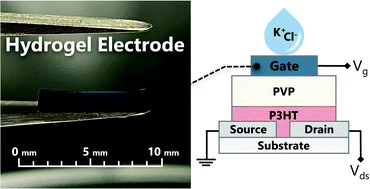PEDOT:PSS hydrogel gate electrodes for OTFT sensors†
Abstract
Organic thin film transistors (OTFTs) have been extensively investigated for biosensing and bioelectronic applications. The conducting polymer poly(3,4-ethylenedioxythiophene) doped with poly(styrene sulfonate) (PEDOT:PSS) has been widely used in these devices, typically in the form of solid thin films. These films, while flexible, exhibit mechanical properties that differ significantly from soft biological materials, such as brain tissue. Hydrogels, by contrast, are intrinsically better suited to interfacing with soft, delicate biological materials. In this work, we investigate PEDOT:PSS-based hydrogels, for use as the top gate electrode in low-voltage hygroscopic insulator field effect transistors (HIFETs). We describe our method for fabricating patterned PEDOT:PSS hydrogel electrodes and report their electrical and rheological properties. We also show that HIFETs using PEDOT:PSS hydrogel gate electrodes exhibit good transistor characteristics and operate at low voltages (−1 V ≤ Vds ≤ 0 V). Further, we demonstrate that hydrogel-gated HIFETs exhibit excellent sensitivity to aqueous potassium chloride (KCl) and sodium chloride (NaCl), as well as hydrogen peroxide (H2O2) over a range of concentrations. Lastly, we show that HIFET sensors can be translated to selective sensing of ions by demonstrating selective sensing of K+ ions. Our results represent an important step forward in the development of HIFETs as soft and conformable sensors.

- This article is part of the themed collection: Journal of Materials Chemistry C Emerging Investigators


 Please wait while we load your content...
Please wait while we load your content...